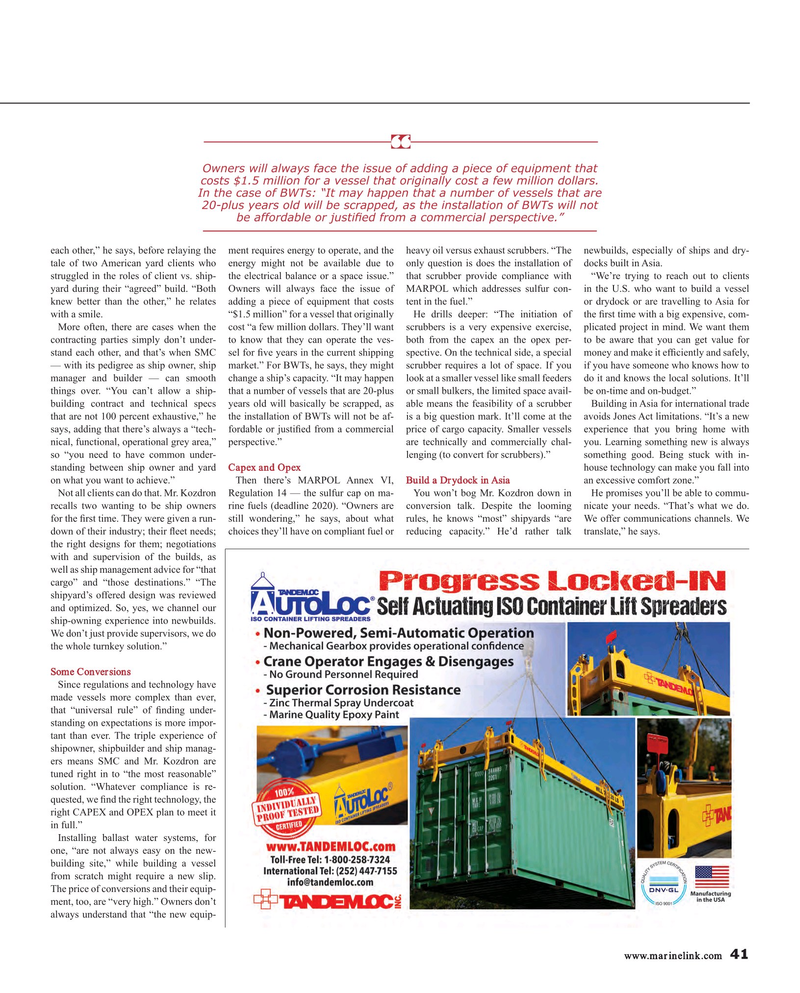
Page 41: of Maritime Reporter Magazine (August 2017)
The Shipyard Edition
Read this page in Pdf, Flash or Html5 edition of August 2017 Maritime Reporter Magazine
“
Owners will always face the issue of adding a piece of equipment that costs $1.5 million for a vessel that originally cost a few million dollars.
In the case of BWTs: “It may happen that a number of vessels that are 20-plus years old will be scrapped, as the installation of BWTs will not be affordable or justi? ed from a commercial perspective.” each other,” he says, before relaying the ment requires energy to operate, and the heavy oil versus exhaust scrubbers. “The newbuilds, especially of ships and dry- tale of two American yard clients who energy might not be available due to only question is does the installation of docks built in Asia.
struggled in the roles of client vs. ship- the electrical balance or a space issue.” that scrubber provide compliance with “We’re trying to reach out to clients yard during their “agreed” build. “Both Owners will always face the issue of MARPOL which addresses sulfur con- in the U.S. who want to build a vessel knew better than the other,” he relates adding a piece of equipment that costs tent in the fuel.” or drydock or are travelling to Asia for with a smile. “$1.5 million” for a vessel that originally He drills deeper: “The initiation of the ? rst time with a big expensive, com-
More often, there are cases when the cost “a few million dollars. They’ll want scrubbers is a very expensive exercise, plicated project in mind. We want them contracting parties simply don’t under- to know that they can operate the ves- both from the capex an the opex per- to be aware that you can get value for stand each other, and that’s when SMC sel for ? ve years in the current shipping spective. On the technical side, a special money and make it ef? ciently and safely, — with its pedigree as ship owner, ship market.” For BWTs, he says, they might scrubber requires a lot of space. If you if you have someone who knows how to manager and builder — can smooth change a ship’s capacity. “It may happen look at a smaller vessel like small feeders do it and knows the local solutions. It’ll things over. “You can’t allow a ship- that a number of vessels that are 20-plus or small bulkers, the limited space avail- be on-time and on-budget.” building contract and technical specs years old will basically be scrapped, as able means the feasibility of a scrubber Building in Asia for international trade that are not 100 percent exhaustive,” he the installation of BWTs will not be af- is a big question mark. It’ll come at the avoids Jones Act limitations. “It’s a new says, adding that there’s always a “tech- fordable or justi? ed from a commercial price of cargo capacity. Smaller vessels experience that you bring home with nical, functional, operational grey area,” perspective.” are technically and commercially chal- you. Learning something new is always so “you need to have common under- lenging (to convert for scrubbers).” something good. Being stuck with in- standing between ship owner and yard Capex and Opex house technology can make you fall into on what you want to achieve.” Then there’s MARPOL Annex VI, Build a Drydock in Asia an excessive comfort zone.”
Not all clients can do that. Mr. Kozdron Regulation 14 — the sulfur cap on ma- You won’t bog Mr. Kozdron down in He promises you’ll be able to commu- recalls two wanting to be ship owners rine fuels (deadline 2020). “Owners are conversion talk. Despite the looming nicate your needs. “That’s what we do. for the ? rst time. They were given a run- still wondering,” he says, about what rules, he knows “most” shipyards “are We offer communications channels. We down of their industry; their ? eet needs; choices they’ll have on compliant fuel or reducing capacity.” He’d rather talk translate,” he says. the right designs for them; negotiations with and supervision of the builds, as well as ship management advice for “that cargo” and “those destinations.” “The shipyard’s offered design was reviewed and optimized. So, yes, we channel our ship-owning experience into newbuilds.
We don’t just provide supervisors, we do the whole turnkey solution.”
Some Conversions
Since regulations and technology have made vessels more complex than ever, that “universal rule” of ? nding under- standing on expectations is more impor- tant than ever. The triple experience of shipowner, shipbuilder and ship manag- ers means SMC and Mr. Kozdron are tuned right in to “the most reasonable” solution. “Whatever compliance is re- quested, we ? nd the right technology, the right CAPEX and OPEX plan to meet it in full.”
Installing ballast water systems, for one, “are not always easy on the new- building site,” while building a vessel from scratch might require a new slip.
The price of conversions and their equip- ment, too, are “very high.” Owners don’t always understand that “the new equip- www.marinelink.com 41
MR #8 (34-41).indd 41 MR #8 (34-41).indd 41 8/4/2017 10:55:21 AM8/4/2017 10:55:21 AM

 40
40

 42
42
